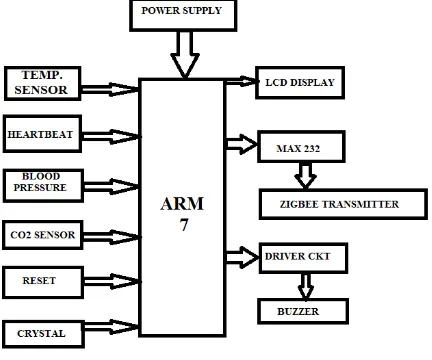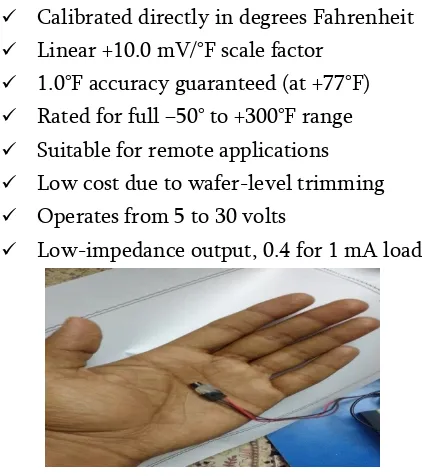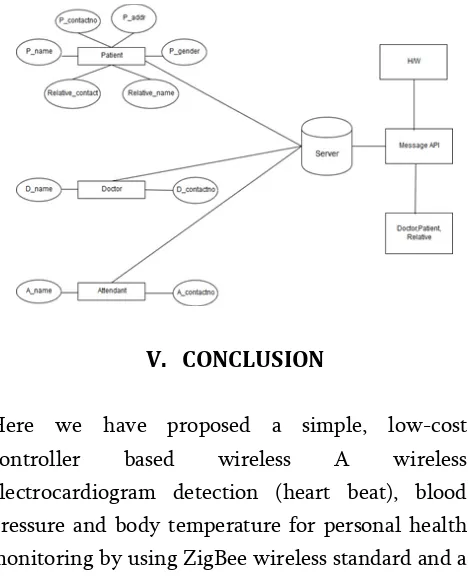ICU Surveillance System
Manali Patil1, Amit Raut1, Bhagyashri Kelkar1, Piyush Latkar1, Samrat Shah1, Abhijit Chougule2 1Student, Department of CSE, Sanjay Ghodawat Institute, Atigre, Maharashtra, India
2Assistant Professor, Department of CSE, Sanjay Ghodawat Institute, Atigre, Maharashtra, India
ABSTRACT
Health monitoring systems are becoming smarter day by day. They are drastically changing the way in which health care support is delivered. They update monitoring patients tasks and improve the workflow management. The Advanced techniques of embedded computing systems has resulted in emergency of Wireless Sensor Networks (WSNs), which gives unique opportunities to sense the physical environment of our daily lives. ZigBee had compliant about WSN platforms which have been proposed for Healthcare monitoring, smart home, industrial monitoring, sensor, as well as other applications. The paper give overview of designing of a simple and low cost controller which is based on patient health monitoring system. This system has a simple opto-electronic sensor which is conveniently strapped on the finger, to give us the continuous indication of the signals captured. The Pulse monitor works on both the battery and the main supply. The Heart rate variable is measured by thumb finger using Infra-Red Device (IRD) sensors and the rate is averaged and displayed on a PC. It is ideal for continuous monitoring in operation theaters, I.C. units, biomedical as well in human engineering studies and sports medicine.
Keywords : Smart Health Monitoring, Mobile Health Monitoring
I.
INTRODUCTION
Today increasingly growing number of people with chronic diseases, this is due to different risk factors such as dietary habits, physical inactivity, alcohol consumption etc. According to figures from the World Health Organization, 4.9 million people die from lung cancer from the consumption of snuff, overweight 2.6 million, 4.4 million for elevated cholesterol and 7.1 million for high blood pressure. It is said that in the next 10 years, deaths from chronic diseases will increase by 17%, which means in figures of about 64 million people, chronic diseases are highly found having symptoms, evolution and treatment. If the attention is not monitored and treated early, they may end the patient's life. The common chronic diseases that can be treated and monitored are diabetes, blood pressure, cardiac arrhythmia. Patients with these diseases those have
limitations over their physical condition, economic, emotional and social relations problems. Patients take time to adapt and accept the reality of long-term disease due to the disability.
healthcare provider in emergency situations like medical monitoring, memory enhancement, medical data access, and communication through the SMS or GPRS. The increase in the detection of emergency conditions of patients is due to the continuous health monitoring with clothing-embedded transducers as well as from implantable body sensor networks . Not only the patient, also the families will benefit from these. The systems gives useful methods which help in acquiring and monitoring the physiological signals without disturbing the patient’s normal life which will lead in improvement life.
Microcontroller based wireless temperature and heart beat monitoring have been found suitable for operation in a small office/home environment. They are found to be easy to operate, with Visual LCD. The system also helps doctor or people in family monitor the emergency alarm from patient or elderly people. These systems do not require the patient to be limited to his bed and allow him to move around but requires being within a specific distance from the bedside monitor. The requirements from the system from user point of view are, the system must be simple to use and implement so that it can be reassembled from one place to another place as per the need. It should be operable by any person with authentication so that no need to have special person to administration. This paper proposes a system to monitor patients body temperature, blood pressure, heart rate etc. and if the parameter values specified in the system varies then these parameters are forwarded with SMS to doctors, attendants and patient relatives. Thus based on parameter values patient basic health factors can be monitored from anywhere anytime.
II.
LITERATURE SURVEY
In [15] the authors mention the benefits of increased use of mobile technologies and smart devices in the area of health. Health experts are increasingly taking advantage of the benefits that the technologies bring
to us and providing a significant effect on health care in clinical settings and out of them. The ordinary users are being served from the advantages of MHealth (Mobile Health) applications and E-Health (health care supported by ICT) to improve, help and assist their health. The Internet of things allow the integrating devices which are capable of connecting to the Internet and providing information on the state of health of patients and providing information in real time to doctors who assist the patients. It is clear that chronic diseases such as diabetes, heart and pressure are remarkable in the world economic and social level problem. The authors propose architecture based on ontology capable of monitoring the health and workout routine recommendations to patients with chronic diseases.
Today, wireless network provide mobile
telemedicine [16] which allows patients to engage their daily routines while they are monitored continuously anytime, anywhere. In healthcare application wireless sensor network small, lightweight sensors are used to be placed on the patients, or microprocessor-based card in portable system. In this case, the disadvantage is the restriction of patient movement. A wire-free system connected to a hospital minicomputer allows the patient mobility within the restricted area of hospital. Tape systems for recording ECG signals are bulky, heavy and prone to mechanical failure. In addition, these systems need large batteries. In order to reduce the size, weight and power consumption of the system, a single chip microcontroller called as
architecture was chosen. To keep the patient free of movement at home, a data transmission protocol using e-mail is implemented in the system.
III.
PROPOSED SYSTEM
We propose a health monitoring system using TI CC2430 and CC2431 chipsets with Z-Stack designed for outdoor patients. The healthcare monitoring system is for tracking patients, and helping doctors and nurses to keep tabs on their patients’ health remotely. Server always keeps track on defined parameters. All the sensors are connected to patient’s body and system will start monitoring the parameters. When the parameter readings are varying from upper limit or lower limit then SMS is send to the details stored in the database. Information on all the contact details and name of the respective doctors, attendants, and relatives is captured as onetime activity by the system.
Figure 1. shows architecture and system stages. In data Capturing module, data or measurements such as Temperature, Pulse rate and Blood pressure of a patient will be captured. In parameter setting module, different parameters for temperature, pulse rate and blood pressure can be entered and modified for further analysis of the data. The roles module is used to define roles such as Doctor, Attendant, Relatives and the patient status information will be given to these people from time to time. Server module will check all the parameters which are captured and will keep records of every patient.
We propose to use Arduino Nano which is a small, complete, and breadboard-friendly board based on the ATmega328 (Arduino Nano 3.x). It has more or less the same functionality of the Arduino Duemilanove, but in a different package. It lacks only a DC power jack, and works with a Mini-B USB cable instead of a standard one. We also use IC LM334 temperature sensor. It has pins VCC, GND and DATA. DATA produced by sensor is in the analogue form.
The features of temperature sensor are
- Operates From 1V to 40V
0.02%/V Current Regulation
Programmable From 1µA to 10mA
Available as Fully Specified Temperature Sensor
≈+0.33%/°C temperature dependence. Zero drift operation can be obtained by adding one extra resistor and a diode. connecting these local networks (or individual IoT devices) to the Internet. The connectivity technologies are NFC, Bluetooth, Zigbee, cellular network etc. In this paper, we use cellular network connectivity because of it has widespread mobile networks like 3G and LTE provide reliable high-speed connectivity to the Internet. However, they have a high power consumption profile and they are
not suitable for M2M or local network
communication.
IV.
COMPONENT DISCRIPTION
Microcontroller:
Choosing a microcontroller from a number of different microcontrollers is a very critical decision for the designers. Three are the vital major criteria for selecting them. These are (a) wide availability and reliable sources (b)meeting the requirements efficiently and cost effectively (c) availability of the software development tools like compilers, Assemblers and debuggers etc .
ARM processor is one of the family of CPU based
RISC (Reduced Instruction Set Computer)
architecture developed by Advanced RISC Machines (ARM). ARM makes 32-bit and 64-bit RISC multi-core processors. RISC processors are designed to perform a smaller number of types of computer instructions so that they can operate at a higher speed, performing more millions of instructions per
second (MIPS). ARM processors are extensively used in electronic devices such as smart phones, tablets, multimedia players. The ARM processor core originates within a British computer company called Acorn. In the mid-1980s they were looking for replacement for the 6502 processor used in their BBC computer range, which were widely used in UK schools. None of the 16-bit architectures becoming available at that time met their requirements, so they designed their own 32-bit processor.
The explosion in wireless technology has seen the emergence of many standards, especially in the industrial, scientific and medical (ISM) radio band. There have been a multitude of proprietary protocols for control applications, which bottlenecked interfacing. Need for a widely accepted standard for communication between sensors in low data rate wireless networks was felt. As an answer to this dilemma, many companies forged an alliance to create a standard which would be accepted worldwide. It was this Zigbee Alliance that created Zigbee. Zigbee has been developed looking into the needs of communication of data with simple structure like the data from the sensors.
A sensor is a device that measures a physical quantity and converts it into a signal which can be read by an observer or by an instrument. For example, a
mercury-in-glass thermometer converts the
measured temperature into expansion and
contraction of a liquid which can be read on a calibrated glass tube. A thermocouple converts temperature to an output voltage which can be read by a voltmeter. For accuracy, most sensors are calibrated against known standards.
There are main 3 types of sensor used in this system:
Temperature sensor:
In this circuit, parameter values commonly used are:
Vc = 4 to 30v
Ra = Vc /10-6
Actually, it can range from 80 KW to 600 KW , but most just use 80 KW.
The LM35 is a precision Fahrenheit temperature sensor which consists of standard TO-92 package which is suitable for remote applications and direct PCB mounting. The LM34 has a wide operating voltage range from 5 to 30 volts DC and also a temperature range from -50° to +300°F.
Figure 2. LM35 temperature sensor Features:
Calibrated directly in degrees Fahrenheit Linear +10.0 mV/°F scale factor
1.0°F accuracy guaranteed (at +77°F) Rated for full −50° to +300°F range Suitable for remote applications Low cost due to wafer-level trimming Operates from 5 to 30 volts
Low-impedance output, 0.4 for 1 mA load
Figure 3. Body Temprature Measurement
Blood pressure sensor:
Working of both sensor is same so choosing any one sensor among of them is only depending on the cost of sensor and we are using sensor only because cost of this sensor is less.The Vernier Blood Pressure Sensor is used to measure systemic arterial blood pressure in humans (non-invasively). When used with Logger Pro® 3.4 or newer, Logger Lite® 1.3.1 or
newer, or LabQuest® App 1.2 or newer, it can
measure mean arterial blood pressure and calculate both the systolic and diastolic blood pressure using the oscillometric method.
The following is a partial list of activities and experiments that can be performed using this sensor.
Measure blood pressure before and after exercise. Measure blood pressure while sitting or standing.
How the Blood Pressure Sensor Works
The active sensor in this unit is a Honeywell SSC Series pressure transducer. The sensor produces an output voltage that varies with the pressure measured in the cuff. It includes special circuitry to minimize errors caused by changes in temperature. We also provide a filtering circuit that conditions the signal from the pressure transducer. The output voltage from the Blood Pressure Sensor is linear with respect to pressure.
Heart beat sensor:
The heart is a muscle. It pushes blood through the arteries, causing them to expand and scontract in response to the flow of blood. You can feel the expansions and contractions, your pulse or heartbeat, in many places throughout the body where an artery passes close to the skin. Taking your pulse — measuring how many times the heart beats in a minute — helps make you aware of your heart rhythm and the strength of your heartbeat.
heart, while pulse rate measures the rate at which blood pressure increases throughout the body. In individuals with specific heart conditions that prevent the heart from pumping blood efficiently with each contraction, the pulse rate can be lower than the heart rate. But that is an exception.
Heart rate is the speed of people's emotional state, exercise intensity and objective indicator of cardiac function. But most people are very difficult to accurately measure the time and his heart rate values. If the heart rate monitor with me, heart ECG electrodes will be detected by monitoring the signal processing device, the user can at any time that your heart rate changes, changes in heart rate, self-monitoring status.
Figure 4. Heartbeat Measurement
Following is the ER diagram of the proposed system
V.
CONCLUSION
Here we have proposed a simple, low-cost
controller based wireless A wireless
electrocardiogram detection (heart beat), blood pressure and body temperature for personal health monitoring by using ZigBee wireless standard and a
circuit containing AT89S52 MCU.
VI.
REFERENCES
[1]. K. Navya, Dr. M. B. R. Murthy, "A Zigbee Based Patient Health Monitoring System", Int. Journal of Engineering Research and Applications Vol. 3, Issue 5, Sep-Oct 2013, pp.483-486
[2]. Matthew D'Souza, Montserrat Ros, Adam Postula, "Wireless Medical Information System Network for Patient ECG Monitoring.
[3]. C.C.Gavimath, Krishnamurthy Bhat, C.L. Chayalakshmi , R. S. Hooli and B.E.Ravishankera, "Design and Development of versatile saline flow rate measuring system and GSM based remote monitoring device", International Journal of Pharmaceutical Applications ISSN 0976-2639.
[4]. NakulPadhye and Preet Jain, "Implementation of ARM Embedded Web Server for DAS using Raspberry pi", VSRD IJEECE April 2013 .
[5]. Ch. Sandeep Kumar Subudhi and S. Sivanandam, "Intelligent Wireless Patient Monitoring and Tracking System(Using Sensor Network and Wireless Communication)", International Journal of Interdisciplinary and Multidisciplinary Studies,2014,Vol 1,No.3,97-104.
[6]. Hossein Fotouhi, Aida Causevic, Kristina lundqvist , Mats bjorkman," Communication and Security in Health monitoring System – A Review", 2016 IEEE 40th Annual computer software and application conference, DOI 10.1109/COMPSAC.2016.8.
[7]. F. Samie and L. Bauer and C.-M. Hsieh et al. Online binding of applications to multiple clock domains in shared fpgabased systems. In DATE, pp. 25–30, 2016.
[8]. Farzad Samie, Lars Bauer, Jörg Henkel, "IoT T echnologies for Embedded Computing: A Survey", ESWEEK’16, October 2-7 2016, Pittsburgh, PA, USA.
[9]. K. Ma, Y. Zheng, S. Li, "Architecture exploration for ambient energy harvesting nonvolatile processors", in HPCA, pp. 526–537
[11]. Pereira, C. 1985. The Management of Tropical Watersheds. Paper presented to the FAO/ICIMOD/East-West Center "Expert Meeting on Strategies, Approaches and Systems for Integrated Watershed Management". Kathmandu, Nepal.
[12]. https://en.wikipedia.org/wiki/WMS_(hydrology_s oftware)
[13]. http://www.scisoftware.com/products/wms_over view/wms_overview.html


